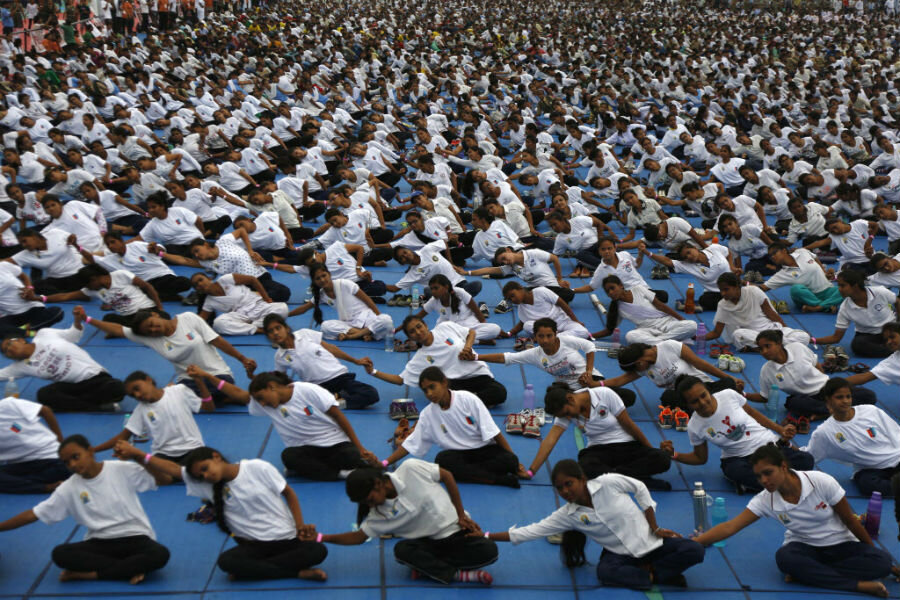Why is the United Nations promoting yoga?
Loading...
On Dec. 11, 2014 a wildly popular resolution was introduced to the United Nations General Assembly. A record number of countries – 175 – were willing to co-sponsor, making it so popular, it was adopted without a vote. But the resolution was not so much a political posture, as a physical one – or rather multiple postures, or asanas, as they are called in this case.
The resolution established June 21 as the International Day of Yoga. That date, the longest in the calendar year, was suggested by Indian Prime Minister Narendra Modi, who first brought the idea of the observance before the General Assembly.
"Yoga is not just about exercise; it is a way to discover the sense of oneness with yourself, the world and the nature," Mr. Modi said in a statement.
Last year was the first time the date was internationally observed, and yogis came out to celebrate across the globe: yoga mats carpeted New York's Times Square as yoga enthusiasts stretched and breathed as they moved between postures; Modi led a record-breaking 35,000 in a yoga class in Delhi; hundreds laid their mats for a yoga session beneath the Eiffel Tower in Paris; and at the UN headquarters, Secretary General Ban Ki-moon donned a white track suit and participated in the practice there.
This year, the United Nations kicked off their celebration Monday night by projecting images of yoga postures onto a side of the New York City headquarters, connecting the practice to living sustainably.
Mr. Ban announced that this year's observation would link the practice of yoga to the Sustainable Development Goals that were adopted by the UN member states last year.
The sustainable development goals are a diverse set of 17 specific targets that include ending poverty and hunger, promoting clean water and sanitation, focusing on climate action, and the preservation of flora and fauna – political and environmental goals that may not seem immediately linked to the ancient practice of yoga, which developed on the subcontinent of India as a discipline for the body and the mind.
In a statement, Ban elaborates on how yoga relates to these global goals.
"Practicing yoga can help raise awareness of our role as consumers of the planet's resources and as individuals with a duty to respect and live in peace with our neighbors," said Ban in an official statement. He also noted that cultivated a practice of yoga can "help people in emergency situations to find relief from stress."
The practice of yoga has spread across the world in the past two centuries, and gained vast popular appeal in the Western world. With its meditative component, it has come to be known worldwide not just as physical exercise but a mental one. Yoga has even come to be incorporated into mental health therapy for the treatment of trauma.
"As Indians we are proud of it. But it does not belong to India. The very fact that the UN has declared an International Yoga Day means India has gifted it to the world. It does not belong to India any more," yoga master Sadhguru Jaggi Vasudev said at a UN meeting on Monday.
However, the global spread of yoga has not come without critique, particularly because of the spiritual component of the practice, which some feel interferes with their expressions of faith. In a homily at the Vatican last year, Pope Francis cautioned Catholics against believing that yoga could open them up to God, saying "only the Holy Spirit can teach us how to love and free us from our hardened hearts." In the US, some parents whose children's school created a mindfulness class expressed concern that the program was inculcating religious and spiritual beliefs they did not necessarily share.
There have been critics of the International Day of Yoga itself in India, where dissenters have suggested that Modi's proposal was linked to a plan to promote Hinduism at the cost of the country's other religions. In his comments on Tuesday morning, Modi alluded to such criticism.
"Yoga is not about the other life. Therefore, it is not a religious practice," Modi said to a crowd of 30,000 in Chandigarh during a mass yoga session. "It is the science of this world, it is about what we will get in this life."







